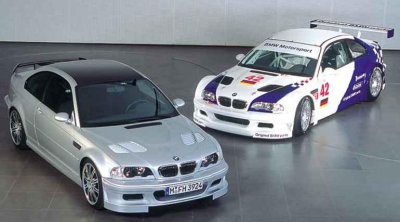 |
The BMW M3 GTR - based on the E46 model - is another addition to that fine BMW tradition of saloon cars that successfully challenged Porsche in the GT/sports car racing category. And what we have is another example of clever designers and engineers exploiting badly worded rules! Up to the end of 2000, the M3 had been had been campaigned successfully for a half-decade in US sports car racing (IMSA GTS-2 and SportsCar GTS-3) in the hands of the Virginia-based Prototype Technology Group (PTG) team, supported by BMW North America. For 1999, PTG raced the E46 in the newly founded American Le Mans series (ALMS) competing in the lower GT category. In 2000, the series featured two European legs at Silverstone and Nurburgring and the black, white and red Yokahama-sponsored PTG cars came along for the ride. At this time, the main BMW factory effort was focused on the 1999 Le Mans winning V12 LMR in the prototype class and the M3 was beginning to struggle against the newly introduced Porsche 911 GTR3. The M3's 3.2 litre straight-six engine had reached the end of its development and PTG had simply wrung out every last scrap of power. Because of the rules relating to the intake restrictor plate combined with the smaller, high-revving 6-cylinder engine, there was little more they could do. However, at the end of the 2000 season, the V12 LMR racing program reached its conclusion and the car was retired. The LMR had been designed and constructed by Williams Grand Prix Engineering in the UK and developed and raced by Charly Lamm and the Schnitzer team, long-time BMW partners. As noted, PTG were not doing demonstrably well with the M3 against their historic rivals - Porsche - in ALMS and now Schnitzer had no race program. And so, orders came down from BMW's Munich headquarters to both BMW Motorsport and Schnitzer - to take the M3 and turn it into a Porsche-beater again. To achieve this, it was quickly realised that a replacement had to be found for the six-cylinder engine. The solution was a new purpose-built 400 hp 4.0-litre V8 unit. This decision was finalised in September 2000, leaving the winter of 2000-2001 to develop the all-new car and engine. Albert Biermann, who was appointed as BMW's program manager for the M3 GTR, oversaw engine and electronic development. The design and construction phase was completed by mid-January 2001 and the first cars were built in early February with the help of Schnitzer. The V8 M3 used the same basic chassis as the six-cylinder racer. As required by the rules, it was based on the production body shell but BMW added a welded safety-cage, racing suspension, CFRP bodywork, front and rear wings and a data-acquisition system. The first test outing was carried out at the BMW circuit at Ismaning near Munich on March 3rd. The signs were good and it looked as if BMW had a winner on their hands. The only remaining problem was that the ALMS rules (based on the same Le Mans rules as administered by the ACO) stated that the racing vehicle must be based on a production model that would be on sale on two continents within 12 months of the rules being issued. As the production M3 retained the six-cylinder engine, the M3 GTR would not be legal. To overcome this, BMW M was to build a highly limited run of spectacular road-licensed M3 GTRs. In fact, ten cars were produced and were offered for sale a year later in January 2002 on two continents - just as the rules said.
|
 |